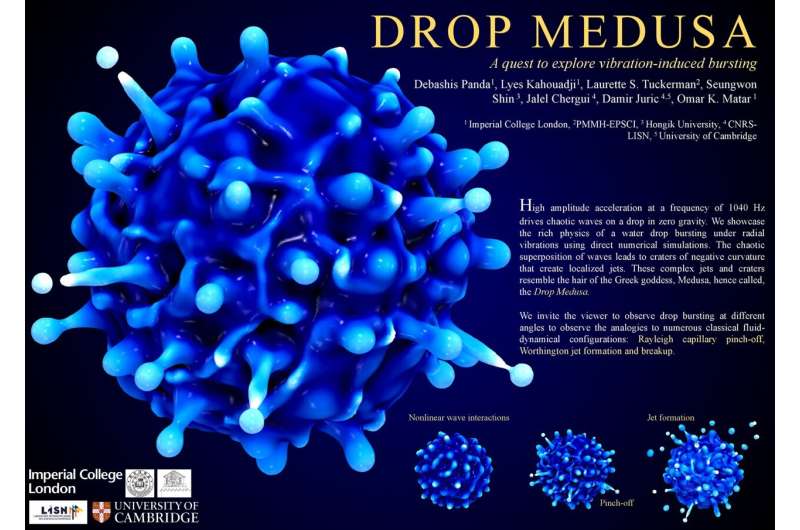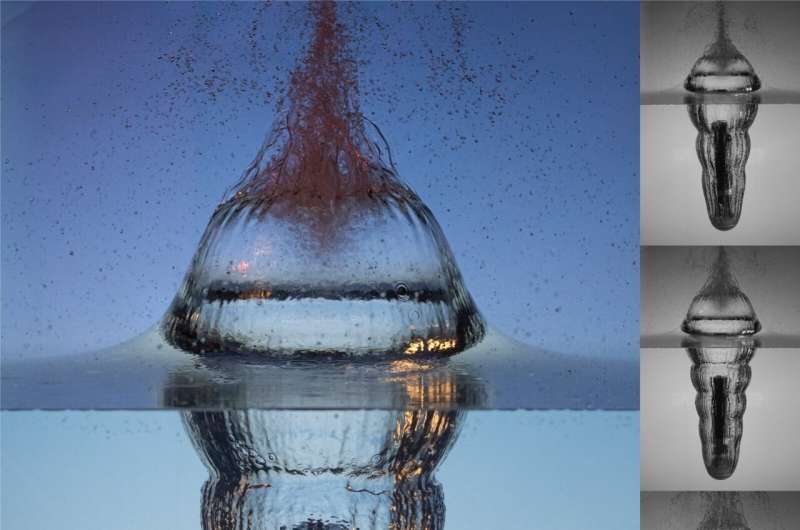December 16, 2023 feature
This article has been reviewed according to Science X's editorial process and policies. Editors have highlighted the following attributes while ensuring the content's credibility:
fact-checked
trusted source
proofread
From 'liquid lace' to the 'Drop Medusa,' researchers compete for the best image of fluid flow

Each year at its annual meeting, the American Physical Society's Division of Fluid Dynamics sponsors a contest for the best images in a variety of categories, all related to the flow of fluids.
This year's Gallery was presented at the Division's 76th meeting in November in Washington, D.C., with 12 artistic videos and images being selected in four different categories. Here are some of the winners.
'Liquid lace'
3D polymer printers require careful adjustment to spool their material out into a substrate. Depositing too much polymer too slowly can lead to pattern-forming kinks or coils in the thread's layout as part of the thread piles up on itself. Piling on top of an existing kinky coil can lead to disorder and structural instabilities (see video).
Here, a team from Princeton University records the pattern when too little material is printed too slowly. The resulting pattern gives layers that are orderly and stable, a kind of "lace" with gaps in part of the structure, using less material and making printing faster.
The gaps in the lace can be controlled by the height of the layer and the rate of printing, which change the density of the final printed structure. Watch the video while enjoying Bach's Violin Sonata No. 2 in A Minor.
'Drop Medusa'
Inducing vibrations in a small liquid drop in zero gravity creates a startling pattern of "jets" and "craters" that somewhat resemble the husk on the seed of a chestnut tree.
These researchers, who created this image from numerical simulations, liken it to the hair of the Medusa, the Greek goddess who turned onlookers to stone. Hence they call their image the "Drop Medusa" (shown at the start of this article).
Radial vibrations of high amplitude at a regular frequency of 1040 Hertz vibrations lead to chaotic, nonlinear waves where the wave superpositions create the jet and crater effect as the drop bursts apart.
'Hydroelastic'
As a display of the interplay between the hydrodynamics and elasticity ("hydroelasticity") this group photographed objects dropped onto a liquid water surface. If the object enters the water with enough speed, an air cavity forms around it, beneath the surface.
Usually this cavity has smooth walls, but for certain impactors the impact's force creates vibrations that leave a nest of curious wavers or undulations along the walls of the air cavity. Understanding this interplay could, as the authors write, "have implications for biological divers or engineered naval and aerospace structures."

Dynamics of frost propagation
Water droplets form when moisture comes into contact with a cold surface, called "breath figures." The droplets coalesce into larger droplets, with new, smaller droplets forming in the empty spaces between them. In this video a sudden cooling of the underlying surface shows the droplets freezing and releasing latent heat, viewed with an infrared camera.
The droplets freeze from the surface up; frost propagates up the surface of the water condensation figures by freezing individual droplets and forming ice bridges between them, ending with a delightful point atop the frozen droplets. The video here shows some of the beautiful features and movements.
More gallery entries can be found here. The "Traveling Gallery of Fluid Motion" exhibition, presented by the American Physical Society—Division of Fluid Dynamics, can be seen at the Cultural Program of the National Academy of Sciences (CPNAS) from October 2, 2023, to February 23, 2024. Titled "Chaosmosis: Assigning Rhythm to the Turbulent," it is at 2101 Constitution Ave., N.W., Washington, D.C., National Academy of Sciences Building, Upstairs Gallery.
More information: Source: Gallery of Fluid Motion, Presented by the APS Division of Fluid Dynamics, gfm.aps.org/
Lauren Dreier et al, Video: Liquid lace, 76th Annual Meeting of the APS Division of Fluid Dynamics—Gallery of Fluid Motion (2023). DOI: 10.1103/APS.DFD.2023.GFM.V0087
Debashis Panda et al, Poster: Drop Medusa, 76th Annual Meeting of the APS Division of Fluid Dynamics—Gallery of Fluid Motion (2023). DOI: 10.1103/APS.DFD.2023.GFM.P0030
John Antolik et al, Poster: Hydroelastic, 76th Annual Meeting of the APS Division of Fluid Dynamics—Gallery of Fluid Motion (2023). DOI: 10.1103/APS.DFD.2023.GFM.P0008
David Paulovics et al, Video: Dynamics of Frost Propagation, 76th Annual Meeting of the APS Division of Fluid Dynamics—Gallery of Fluid Motion (2023). DOI: 10.1103/APS.DFD.2023.GFM.V0079
© 2023 Science X Network




















